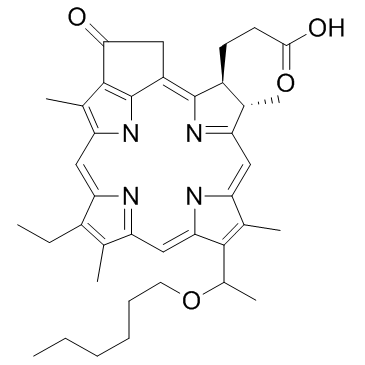Photochlor(HPPH)
Published date: 2017-07-07 16:22:46
| Name | HPPH | CAS# | 149402-51-7 | |
|---|---|---|---|---|
| Price | ¥Inquiry/100mg ¥Inquiry/500mg ¥Inquiry/1g ¥Inquiry/5g | Purity | 98.0% | |
| Stocking Period |
Inquiry | Stock | In Stock |
| Detail
Product Information
Product Name: Photochlor(HPPH); Photosensitive Drug; 2-(1-Hexyloxyethyl)-2-devinyl pyropheophorbide-a CAS No.: 149402-51-7 Chemical Name: (3S,4S)-14-Ethyl-9-[1-(hexyloxy)ethyl]-4,8,13,18-tetramethyl-20-oxo-3-phorbinepropanoic acid; 3-Devinyl-3-(1'-hexyloxy)ethylpyropheophorbide A; 2-[1'-(Hexyloxy)ethyl]-2-devinylpyropheophorbide A Molecular Formula: C39H48N4O4 Molecular Weight: 636.82 Appearance:Dark black powder Assay(HPLC,Anhydrous substance):>98% Photochlor (HTTP) is a lipophilic, second-generation, chlorin-based photosensitizer. Upon intravenous administration, HPPH selectively accumulates in the cytoplasm of cancer or pre-cancerous cells. When laser light is applied, a photodynamic reaction between HPPH and oxygen occurs, resulting in the production of cytotoxic free radicals and singlet oxygen and free radical-mediated cell death. Compared to the first-generation photosensitizer porfimer sodium, HPPH shows improved pharmacokinetic properties and causes only mild skin photosensitivity which declines rapidly within a few days after administration. 2-(1-Hexyloxyethyl)-2-devinyl pyropheophorbide-a (HPPH; Photochlor) is a photosensitiser chemical that is used in photodynamic therapy. 2-[1-hexyloxyethyl]-2-devinyl pyropheophorbide-alpha (HPPH or Photochlor) as a photosensitizer for the treatment of malignant gliomas by photodynamic therapy (PDT). |



